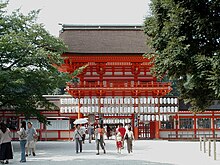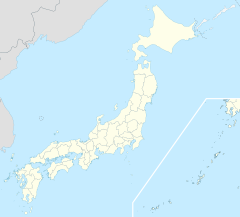Shimogamo Shrine (Japanese: 下鴨神社, Hepburn: Shimogamo-jinja) is an important Shinto sanctuary in the Shimogamo district of Kyoto city's Sakyō ward. Its formal name is Kamo-mioya Shrine (賀茂御祖神社, Kamo-mioya-jinja).[1] It is one of the oldest Shinto shrines in Japan and is one of the seventeen Historic Monuments of Ancient Kyoto which have been designated by UNESCO as a World Heritage Site. The term Kamo-jinja in Japanese is a general reference to Shimogamo Shrine and Kamigamo Shrine, the traditionally linked Kamo shrines of Kyoto;[2] Shimogamo is the older of the pair, being believed to be 100 years older than Kamigamo, and dating to the 6th century, centuries before Kyoto became the capital of Japan (794, see Heian-kyō). The Kamo-jinja serve the function of protecting Kyoto from malign influences.[3]
| Shimogamo Shrine 下鴨神社 | |
|---|---|
 Shimogamo Shrine | |
| Religion | |
| Affiliation | Shinto |
| Deity | Tamakushi-hime (玉依姫命) Kamotaketsunumi no Mikoto (賀茂建角身命) |
| Festival | Aoi Matsuri (Kamo no Matsuri; May 15th) |
| Type | Shikinaisya Yamashiro no Kuni ichinomiya Twenty-Two Shrines Former kanpeitaisha Chokusaisha Beppyo jinja |
| Location | |
| Location | 59 Shimogamo Izumigawa-chō, Sakyō-ku, Kyoto, Kyoto Prefecture |
| Geographic coordinates | 35°02′20″N 135°46′21″E / 35.03889°N 135.77250°E |
| Architecture | |
| Style | Nagare-zukuri |
| Date established | 6th century |
| Website | |
| www | |
The jinja name identifies the Kamo family of kami or deities who are venerated. The name also refers to the ambit of shrine's nearby woods, which are vestiges of the primeval forest of Tadasu no Mori. In addition, the shrine name references the area's early inhabitants, the Kamo clan, many of whom continue to live near the shrine their ancestors traditionally served.[4]
Shimogamo Shrine is dedicated to the veneration of Tamayori-hime (玉依姫, lit. 'the spirit-inviting maiden') and her father, Kamo Taketsunomi (賀茂建角身). Tamayori-hime is the mother of Kamo Wakeikazuchi (賀茂別雷, the thunder-divider of Kamo), who was sired by Honoikazuchi-no-mikoto (火雷神, the God of Fire and Thunder).[5][6] Kamigamo Shrine, the other of the two Kamo shrines of Kyoto, is dedicated to Kamo Wakeikazuchi. These kami are variously associated with thunder.
History
editThe shrine became the object of Imperial patronage during the early Heian period.[7] Shimogamo, along with the Kamigamo Shrine, was designated as one of two chief Shinto shrines (ichinomiya) for the former Yamashiro Province.[8] In 965, Emperor Murakami ordered that Imperial messengers were sent to report important events to Japan's guardian kami, including Kamo-Tamayori-hime and Kamo-Taketsune.[9] The writer of Hōjōki, Kamo no Chōmei (鴨長明), was the second son of one of the head priests of the shrine, Kamo no Nagatsugu (鴨長継).[10] From 1871 through 1946, Shimogamo was officially designated one of the Kanpei-taisha (官幣大社), meaning that it stood in the first rank of government supported shrines.[11] Today, it is one of the most visited sites during the new year, and the popular national pastime game of kemari is often played by Shinto priests.
Imperial visits
edit- 794 (Enryaku 13): Emperor Kanmu came as part of a grand progress.[12]
- 942 (Tengyō 5, 29th day of the 4th month): Emperor Suzaku visited to offer thanks for restoration of peace.[12]
- 979 (Tengen 2, 10th day of the 10th month): Emperor En'yū decided that an Imperial visit Hachiman at Iwashimizu Shrine should be paired with a visit to Kamo.[13]
- 1088 (Kanji 27th day of the 4th month): Emperor Horikawa visited Kamo.[14]
- 1156 (Hōgen 1, 23rd day of the 4th month): Emperor Go-Shirakawa traveled to Kamo.[15]
Structures
editA shrine structure was erected in 678 during the reign of the Emperor Tenmu, and this became the principal building during the reign or of the Emperor Kanmu when he removed the capital from Nara to Heian-kyō.[16]
Shimogamo Shrine (Lower Kamo Shrine) is believed to date to the 6th century.[citation needed]
A model of the Hut described in Hōjōki is located in Kawai Jinja section of the shrine.[17]
Gallery
edit-
Maple leaves and paper lantern at the shrine
-
This pathway leads through Tadasu no Mori (the "Forest Where Lies are Revealed").
-
A pair of torii gates, Kawai-jinja
-
Mitarai-sha
-
Taikobashi bridge
See also
editNotes
edit- ^ Richard, Ponsonby-Fane. (1964) Visiting Famous Shrines in Japan, pp. 1-118.
- ^ Terry, Philip. (1914). Terry's Japanese empire, p. 479.
- ^ Miyazaki, Makoto. "Lens on Japan: Defending Heiankyo from Demons," Archived 2011-03-21 at the Wayback Machine Daily Yomiuri. December 20, 2005.
- ^ Nelson, John K. (2000). Enduring Identities: The Guise of Shinto in Contemporary Japan, pp. 92-99.
- ^ Kōjien Japanese dictionary, entry for Tamayori-bime.
- ^ Kokugakuin University's digital Encyclopedia of Shinto, entry for Tamayorihime.
- ^ Breen, John et al. (2000). Shinto in History: Ways of the Kami, pp. 74–75.
- ^ "Nationwide List of Ichinomiya," p. 1.; retrieved 2011-08-010
- ^ Ponsonby-Fane. Studies, pp. 116–117.
- ^ Hare, Thomas Blenman. (1989). Reading Kamo no Choumei, p. 174.
- ^ Ponsonby-Fane, Richard. (1959). The Imperial House of Japan, p. 124.
- ^ a b Ponsonby-Fane, Richard. (1964). Visiting Famous Shrines of Japan, p. 47.
- ^ Ponsonby-Fane, Visiting, p. 48.
- ^ Ponsonby-Fane, Visiting, p. 49.
- ^ Ponsonby-Fane, Visiting, p. 50.
- ^ "Shimgamo Shrine". Archived from the original on 2015-01-04. Retrieved 2012-04-24.
- ^ D, John (12 January 2012). "Celebrating Chomei (Shimogamo Shrine)". www.greenshinto.com.
References
edit- Breen, John and Mark Teeuwen. (2000). Shinto in History: Ways of the Kami. Honolulu: University of Hawaii Press. ISBN 978-0-8248-2363-4
- Iwao, Seiichi, Teizō Iyanaga, Susumu Ishii, Shōichirō Yoshida, et al. (2002). Dictionnaire historique du Japon. Paris: Maisonneuve & Larose. ISBN 978-2-7068-1632-1; OCLC 51096469
- Nelson, John K. (2000). Enduring Identities: The Guise of Shinto in Contemporary Japan. Honolulu: University of Hawaii Press. ISBN 978-0-8248-2259-0
- Ponsonby-Fane, Richard. (1959). The Imperial House of Japan. Kyoto: Ponsonby Memorial Society. OCLC 194887
- ____________. (1962). Studies in Shinto and Shrines. Kyoto: Ponsonby Memorial Society. OCLC 399449
- ____________. (1964). Visiting Famous Shrines in Japan. Kyoto: Ponsonby-Fane Memorial Society. OCLC 1030156
External links
edit- Media related to Shimogamo-jinja at Wikimedia Commons
- Shimogamo Shrine website (in Japanese)
